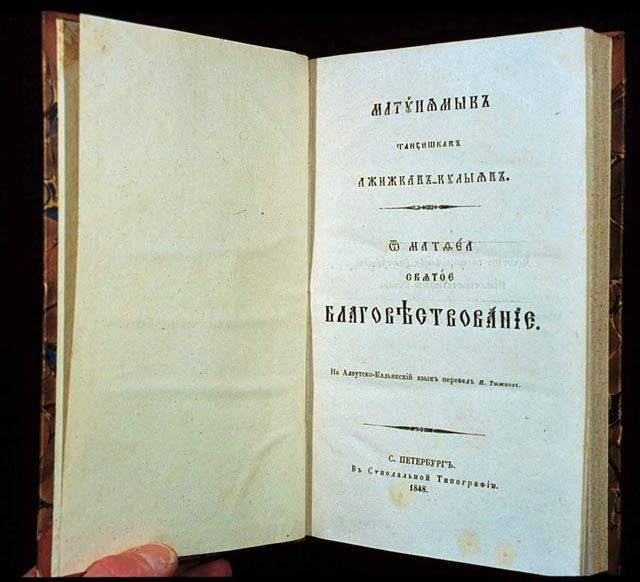Alutiiq Grammar: An Overview
Alutiiq is an agglutinative language. Agglutinative languages are made up of root words and numerous suffixes that add or change meaning. Each word particle has meaning, but rarely can stand on its own as a separate word. In languages like Alutiiq, you can often have whole sentences that are just one long word.
-
KaRtuugarturtaartukut.We all (3+ people) habitually/always eat potatoes.
The Alutiiq language has a complex grammar, but unlike English it is highly regular. There are few exceptions, and once you learn a concept, you can apply it to many other words and sentences. Even without formal instruction, you can compare words with a similar root or similar endings to figure out the underlying grammar.
-
QunukamkenI love you.
-
QunukamciI love you all.
-
TangramkenI see you.
-
TangramciI see you all.
The examples above show that by changing the ending but keeping the same root verb, you can change who you are talking to or about. By changing the root verb but keeping the same suffix (ending), you can keep the same subject and object but be talking about a totally different verb.
Understanding the mechanics of the language, being able to identifying syllables and number endings for example, will help you learn to build sentences. In order to create sentences in Alutiiq, you must understand noun and verb stems, and how to add suffixes to those stems. You can not simply look up words in the dictionary and string them together create a phrase or sentence. Alutiiq and English speakers build sentences in very different ways.
Noun and Verb Roots
A noun is a person, place, or thing. a noun stem, also known as its root, is the base form of the word, which cannot stand on its own. It is this root that Alutiiq postbases and suffixes are added (see next section). A noun root for a singular noun ending in q will end in r, and a singular noun that ends in k will end in g when converted to its root. the root is written with a – at the end to show it is not complete on its own.
-
caskaq (root: caskar-)cup
-
iqalluk (root: iqallug-)fish
A verb is an action or status which may or may not involve any action. “To run” is a verb, but so is “to think,” and “to be sitting.” in Alutiiq, what we think of as adjectives, like “red” or “pretty,” are also treated as verbs. The verb for those examples in Alutiiq would be “to be red” and “to be pretty.”
Verbs in Alutiiq have roots just like nouns do. They must have a suffix added to show the time frame and the subject and object (if applicable) of the sentence. Most of the time verbs are depicted in dictionary form with a luni or luku ending. This ending is dropped to find the root, and then a new suffix is added to create sentence. Putting the word parts together can seem almost like a math equation!
| Tang’rluku | to see something/someone (dictionary form) |
| Tangramken. | I see you. |
| Tangramken = (root: tang’r-) + (suffix: -amken “I to you, present tense”) | |
Postbases and Suffixes
In Alutiiq, speakers make new words by adding postbases (word parts that go after a root) and suffixes (endings that show person, number, tense, etc.) to both nouns and verbs. This system allows nouns to become verbs with the addition of a suffix, and verbs to become nouns. For example, the word iqalluk means fish. The root form of this world is iqallug-. To this root you can add –cunite, a post base meaning “to smell like” and “–uq“, a suffix indicating that the word is a verb in the 3rd person singular form. Together these word parts make Iqallugcunituq, “He smells like fish.” To say what you want to say in Alutiiq, you must know how to use suffixes.

Primer Written In Alutiiq Using Cyrillic Characters, 1848. Alutiiq Museum Collections.
If you ask an Elder about “suffixes,” “postbases,” or the rules of “joining types,” terms from linguistic books, they will not be familiar with these words. However, Elders know the rules for speaking, as they have grown up speaking the language. For example, you may not know the difference between the subject, predicate, and object in an English sentence, but you can speak English without a problem. The rules for proper sentence construction are ingrained in your subconscious, as they are for Alutiiq speakers.
The grammar lessons on this web site will bring you closer to creating simple sentences in Alutiiq, but they will not teach you to speak Alutiiq. It is good to learn about Alutiiq grammatical rules, but the best way to learn how to speak is from a person.
The grammar presented here is compiled from Dr. Jeff Leer’s Classroom Grammar of Koniag Alutiiq, Kodiak Island Dialect and A Conversational Dictionary of Kodiak Alutiiq, with assistance from Philomena Hausler’s Alutiiq Language (Sugt’stun) Lessons, and input from Native speakers.
Don’t Miss a Word!
Sign up for our email broadcast and we’ll send you a weekly language lesson and a link to our podcast.
Language Lessons
- Alutiiq – What is in a Name?
- Alutiiq and other Alaskan Languages
- Origins of the Alutiiq Alphabet
- Dialects and Styles of Alutiiq
- Language Loss & Revitalization
- Alutiiq Orthography
- Aapit – Alphabet
- Vowels
- Doubled Vowels & Diphthongs
- Consonants
- Stop Consonants
- Fricative Consonants
- Nasal Consonants
- Softening of Consonants
- Alutiiq Grammar: An Overview
- Pluralization
- Working with Noun Stems
- Working with Verb Stems
- Suffixes and Other Word Endings
- Postbases and Joining
- Alutiiq in Correspondence
- Kodiak Alutiiq Place Names
- Alutiiq Numbers
